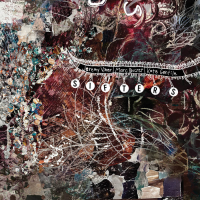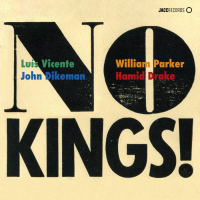Home » Jazz Articles » Album Review » Sun Ra Arkestra: Heliocentric Worlds 1 & 2 Revisited
Sun Ra Arkestra: Heliocentric Worlds 1 & 2 Revisited
Before the release of The Heliocentric Worlds Of Sun Ra Vol. 1 and The Heliocentric Worlds Of Sun Ra Volume 2, knowledge of Ra's music was confined to a tiny audience, pretty much exclusively African American in composition, which followed Ra's Arkestra on its low-profile local gigs and bought the self-released albums that were on sale at the performances. Through the 1950s the Arkestra's territory was Chicago. This was followed by a few months in Toronto, from where Ra moved his community of musicians to New York City in 1961.
Practically from the outset, New York proved to be a relatively receptive new home. For about a year, the Arkestra regularly appeared Greenwich Village's Playhouse, a small cutting-edge venue owned, rather curiously, by Gene Harris, the pianist with the distinctly middle-of-the-road trio The Three Sounds. The impecunious New York newbie Pharoah Sanders took a job in the Playhouse's kitchen in order to be able to catch the Arkestra's performances (and recorded with the band when Ra's regular tenor saxophonist, John Gilmore, was on a leave of absence with Art Blakey). When the avant-garde crucible Slug's opened in the East Village in 1964, the Arkestra soon became a key attraction.
Things really began to happen for Ra in late 1964, after the Arkestra took part in the historic October Revolution concerts at the Cellar Café, a coffeehouse on the Upper West Side. The Cellar Café was licensed to hold just sixty-five customers, but for the six nights of the October Revolution the room was rammed with everybody who was at the sharp end of New York jazz. Among the audience the night the Arkestra appeared was ESP's Bernard Stollman, who had just dipped his label's toes in jazz waters with Albert Ayler's Spiritual Unity. Stollman liked what he heard and in April 1965 Ra and the Arkestra went into the studio to record The Heliocentric Worlds Of Sun Ra Vol. 1. In November, the outfit recorded The Heliocentric Worlds Of Sun Ra Volume 2. The two percussion-heavy albums cross-pollinate space jazz and conservatoiresque art music to the benefit of both, and Volume 2 in particular is a landmark in Ra's development as a composer.
Unlike Ra's own Saturn label, ESP had some semblance of a distribution network in progressive record and book stores in New York, and also in London and other major European cities; and because Stollman was a hustler, and no doubt aided by the fact that he was a white man, he was able to get his foot in the door of the more adventurous end of the mainstream media. In 1965, most jazz critics were unaware of Ra but Stollman persuaded a few of them to check out the Heliocentric Worlds albums. He did not, however, make many converts overnight. Martin Williams, for instance, who had been an early champion of Ornette Coleman and appreciated Albert Ayler and Cecil Taylor, dismissed the second album's side-long "The Sun Myth," arguably the chef d'oeuvre of the two discs (though the shorter and exquisitely delicate "A House Of Beauty" runs it a close second), as "soundtrack music from a bad science fiction movie." Ira Gitler harrumphed about "so called space music and other incoherent goings-on."
Ra found more receptive ears on Willis Conover, Voice of America's jazz disc jockey, who got Ra immediately. Conover played tracks from both Heliocentric Worlds on an almost nightly basis on his jazz show beamed to Europe, where in 1966 an enthusiastic following began to develop. In London and elsewhere, counterculturally inclined disc jockeys and music critics picked up Conover's baton. Ra and the Arkestra became a success d'estime, rather like the early Pink Floyd, and possession of a Ra LP marked you out as among the hip cognoscenti.
Acceptance of Volume 2 was probably assisted by the front cover artwork, which to European eyes was Ra's most striking to date. The cover shows an early German illustration of the solar system above a gallery of portraits of scientists and philosophers chiefly from the sixteenth century: Leonardo da Vinci, Nicolas Copernicus, Galileo Galilei and Tycho Brahe. Right in the middle of them, next to each other, are portraits of Ra and Pythagoras, linking Ra with the Greek astronomer-mathematician-musician who studied in Egypt and whose beliefs were in many respects akin to those espoused by Ra.
As with just about everything that is Ra related, a fog of false leads and misinformation swirls round the provenance of the Heliocentric Worlds albums. In rapid succession in late 1965, for instance, without notification or explanation, ESP released pressings of Volume 2 with radically different mixes of "The Sun Myth." The first has what are best described as "African" voices clearly audible throughout, the second is purely instrumental. A third mix, on a 1968 pressing, has the voices at the track's start and finish only. The no-voices mix is the one heard on most reissues and it is the one on Heliocentric Worlds 1 & 2 Revisited. This is released as part of the Swiss based ezz-thetics label's estimable Revisited series of avant-garde classics from the 1960s. As with all the albums in the series, the music has been state-of-the-art remastered, on this occasion by ezzthetics founder Werner X. Uehlinger's longtime mastering jedi Peter Pfister. The albums sound better than ever.
Muddy Waters Footnote: In 2005, ESP released Heliocentric Worlds Vol. 111. The liner notes assert that the tracks come from the November 1965 sessions which produced The Heliocentric Worlds Of Sun Ra Volume 2. But the personnel and instrumentation is audibly wrong. One track, "Intercosmosis," likely comes from the May 1965 sessions which produced The Magic City (Saturn, 1966)—another tremendous album—and the other tracks come from the April 1965 sessions which produced The Heliocentric Worlds Of Sun Ra Vol. 1. Definitely. Certainly. Probably. Maybe.
Track Listing
Heliocentric; Other Nothingness; Other Worlds; The Cosmos; Heavenly Things; Nebulae; Dancing In The Sun; The Sun Myth; House Of Beauty; Cosmic Chaos.
Personnel
Sun Ra
pianoJohn Gilmore
saxophone, tenorMarshall Allen
saxophone, altoRobert Cummings
clarinet, bassDanny Davis
flugelhornPat Patrick
saxophoneTeddy Nance
tromboneBernard Pettaway
trombone, bassChris Capers
trumpetWalter Miller
trumpetRonnie Boykins
bass, acousticJimhmi Johnson
percussionRoger Blank
drumsAdditional Instrumentation
Sun Ra: electronic celeste, piano, clavioline, tympani, bass marimba, tuned bongos; John Gilmore: tenor saxophone, tympani, percussion; Marshall Allen: piccolo, alto saxophone, bells, spirit cymbals, flute, percussion; Robert Cummings: bass clarinet, wood blocks, percussion; Danny Davis (1-7): flute, alto saxophone; Pat Patrick: baritone saxophone, percussion; Teddy Nance (1-7): trombone; Bernard Pettaway (1-7): bass trombone; Chris Capers (1-7): trumpet; Walter Miller (8-10): trumpet; Ronnie Boykins: double bass; Jimhmi Johnson (1-7): percussion, tympani; Roger Blank (8-10): percussion.
Album information
Title: Heliocentric Worlds 1 & 2 Revisited | Year Released: 2021 | Record Label: Ezz-thetics
Tags
About Sun Ra Arkestra
Instrument: Band / ensemble / orchestra
PREVIOUS / NEXT
Support All About Jazz
 All About Jazz has been a pillar of jazz since 1995, championing it as an art form and, more importantly, supporting the musicians who make it. Our enduring commitment has made "AAJ" one of the most culturally important websites of its kind, read by hundreds of thousands of fans, musicians and industry figures every month.
All About Jazz has been a pillar of jazz since 1995, championing it as an art form and, more importantly, supporting the musicians who make it. Our enduring commitment has made "AAJ" one of the most culturally important websites of its kind, read by hundreds of thousands of fans, musicians and industry figures every month.

























